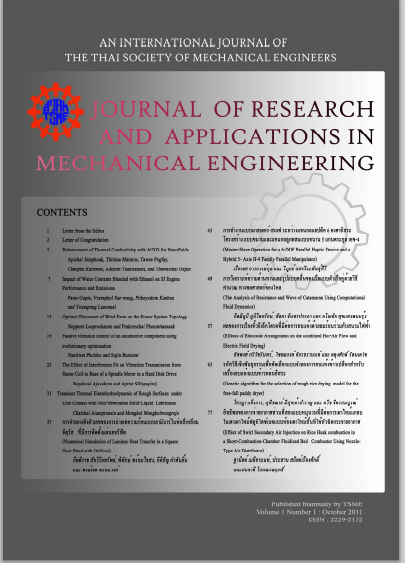Prediction of total equivalence ratio for a self-aspirating burner
Main Article Content
Abstract
A total air entrainment affects the burner performance in terms of completeness of combustion. In recent years, the prediction of a value of the air entrainment for a self-aspirating burner deals only with the primary air, and is also limited to the without preheat case. This study provides a combined theoretical and experimental investigation into the prediction of the total air entrainment for a self-aspirating burner, which is corresponding to the total equivalence ratio. Both with and without preheat of combustion air cases are carried out the primary air entrainment. The oxygen concentration in the mixture is measured by the oxygen sensor. It reveals the level of primary air within this mixture. Calculation method for predicting the total equivalence ratio was developed by using the momentum and energy conservation principles. It is observed that the levels of both primary and secondary air entrainment are increased with increasing the heat input due to the high momentum jet. The preheated case yields a lower primary and secondary air entrainment because of the preheating effect, the fluid in the mixing tube has more viscosity. The levels of total equivalence ratio are in the range of 0.5 to 6. The rich condition is occurred at lower heat input because of the low total air entrainment. At higher heat input, the high momentum jet entrains an excess air. Therefore, the total equivalence ratio becomes very low under lean conditions. The optimum operation of this burner occurs at heat input equals to 7.5 kW, in which the stoichiometric combustion is achieved. As a result, it may be helpful in predicting the thermal efficiency in the future especially in combustion with preheated air.
Article Details
This work is licensed under a Creative Commons Attribution-NonCommercial-ShareAlike 4.0 International License.
References
[2] Jugjai, S., Tia, S. and Trewetasksorn, W. (2001). Thermal efficiency improvement of an LPG gas cooker by a swirling central flame, International Journal of Energy Research, vol. 25(8), May 2001, pp. 657 – 674.
[3] Hou, S.S., Lee, C.Y. and Lin, T.H. (2007). Efficiency and emissions of a new domestic gas burner with a swirling flame, Energy Conversion and Management, vol. 48(5), January 2007, pp. 1401 – 1410.
[4] Jugjai, S. and Rungsimuntuchart, N. (2002). High efficiency heat-recirculating domestic gas burners, Experimental Thermal and Fluid Science, vol. 26(5), April 2002, pp. 581 – 592.
[5] Maughan, J.R., Cahoe, J.R. and Ghassemzadeh, R. (1992), Autoregulation of primary aeration for atmospheric burners, US Patent Number 5104311, USA, URL:http://www.patentstorm.us/patents/5104311.html,access on 02/11/2007
[6] Pritchard, R., Guy, J.J. and Connor, N.E. (1977). Handbook of industrial gas utilization: engineering principles and practice, Van Nostrand Reinhold Co., New York.
[7] Singh, G., Sundararajan, T. and Shet, U.S.P. (1999). Entrainment and mixing studies for a variable density confined jet, Numerical Heat Transfer, Part A: Applications, vol. 35(2), September 1998, pp. 205 – 223.
[8] Singh, G., Sundararajan, T. and Bhaskaran, K.A. (2003). Mixing and entrainment characteristics of circular and noncircular confined jets, Journal of Fluids Engineering, vol. 125(5), September 2003, pp. 835–842.
[9] Namkhat, A. and Jugjai, S. (2007). Primary air entrainment characteristics of a self-aspirating burner, paper presented in the 21st Conference of Mechanical Engineering Network of Thailand, Cholburi, Thailand.
[10] Namkhat, A. and Jugjai, S. (2009). Fundamental Study on Primary Air Entrainment of a Self-aspirating Burner: Comparison on Hot Test and Cold Test Case, paper presented in the World Renewable Energy Congress 2009-Asia, The 3rd International Conference on “Sustainable Energy and Environment (SEE 2009)”, Bangkok, Thailand.
[11] Namkhat, A. and Jugjai, S. (2010). Primary air entrainment characteristics for a self-aspirating burner: Model and experiments, Energy, vol. 35(4), April 2010, pp. 1701 – 1708.
[12] Namkhat, A. and Jugjai, S. (2010). The effect of primary air preheat on the primary aeration of a selfaspirating burner, paper presented in the 1st TSME International Conference on Mechanical Engineering, Ubon Ratchathani, Thailand.
[13] Kline, S.J. and McClintock, F.A. (1953). Describing uncertainties in single-sample experiments, Mechanical Engineering, vol. 75, January 1953, pp. 3 – 8.
[14] Ricou, F.P. and Spalding, D.B. (1961). Measurement of entrainment by axisymmetrical turbulent jets, J. Fluid Mechanics, vol. 11, 1961, pp. 21 – 32.
[15] Turns, Stephen R. (2000). An Introduction to Combustion: Concepts and Applications, 2nd edition, ISBN: 0-07-230096-5, McGraw-Hill, Singapore.



